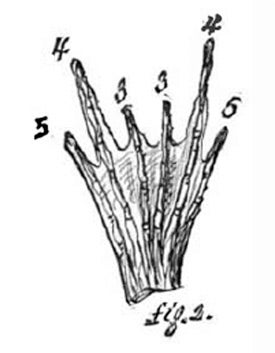This article was published in Scientific American’s former blog network and reflects the views of the author, not necessarily those of Scientific American
Mr. Jacob Stauffer, a naturalist from Lancaster, Pa., sent in this drawing of a five legged frog that was captured in Conestoga, Pa (near Lancaster). It was featured in the September 13, 1879 issue of Scientific American. The extra leg seemed to be a fusion of two hind legs rather than a full-grown independent limb. According to the description, the extra leg was the same shade of green on its top and bottom, while the other four legs changed from green to a brownish-yellow.

On supporting science journalism
If you're enjoying this article, consider supporting our award-winning journalism by subscribing. By purchasing a subscription you are helping to ensure the future of impactful stories about the discoveries and ideas shaping our world today.
Further, the extra leg had six toes instead of five, which were made up of two out digits and one middle digit on each side.

After being captured, the frog was put to work as an entertainer. “He was made to swim and hop to amuse the crowds of callers.” Sadly, his life of fame lasted only five days. “Poor frog, although vigorous and able to use his additional appendage lustily as an oar or leg in his gymnastics, he had just given up when I [Mr. Stauffer] laid him out and took an accurate drawing of the creature, which is now preserved in alcohol for inspection.”